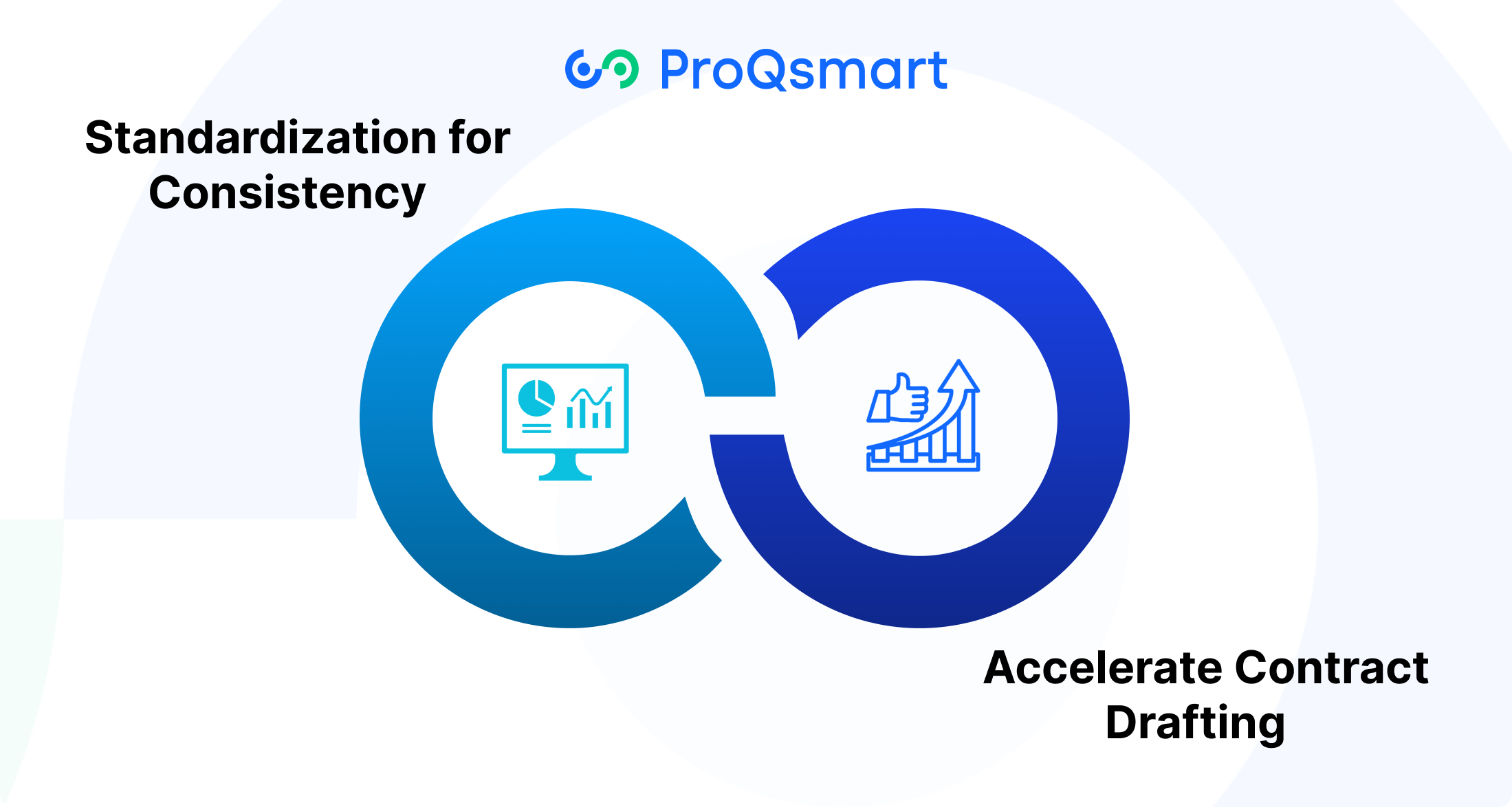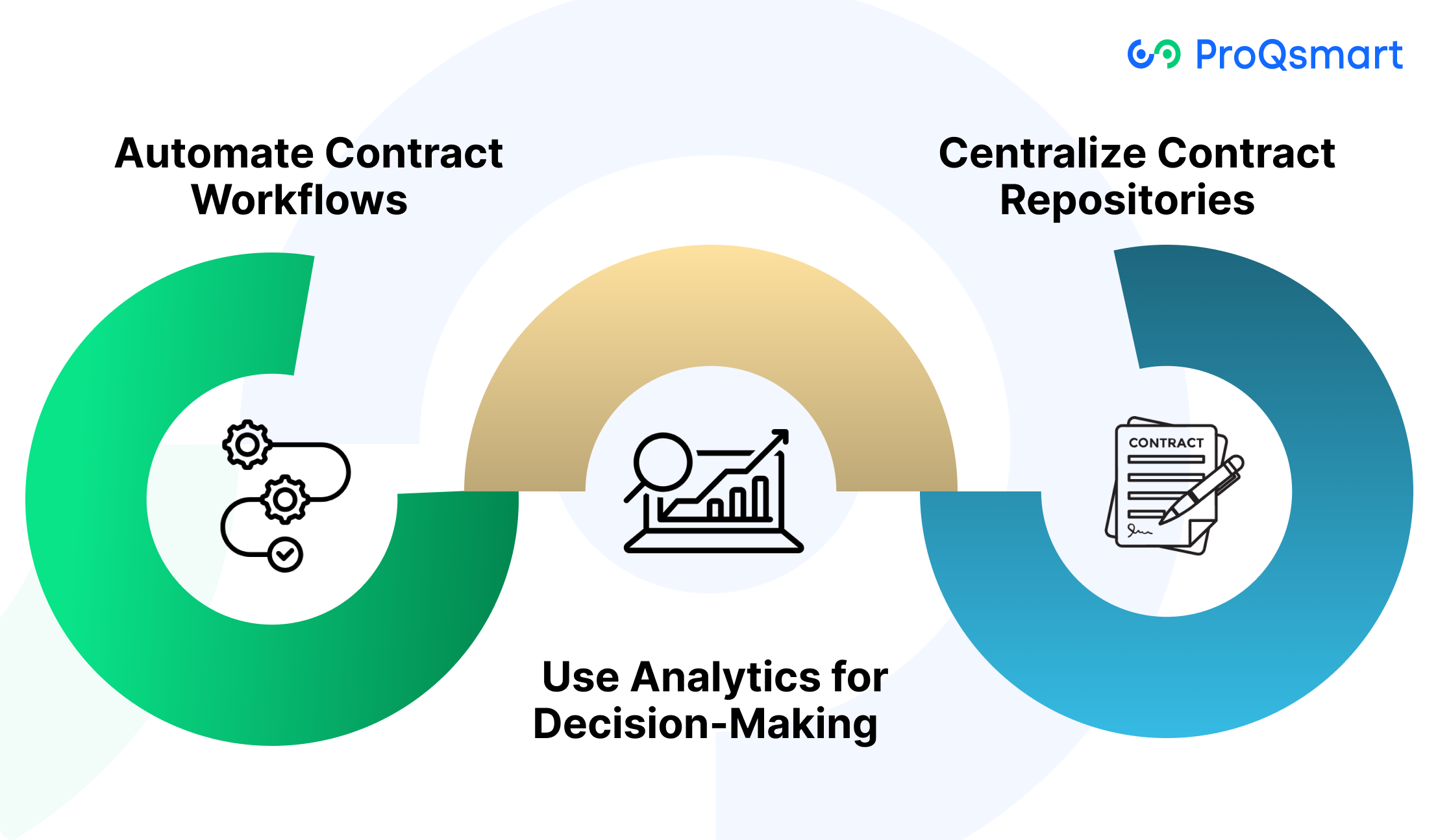A contract management system simplifies the whole contract lifecycle, automating and accelerating processes from creation and negotiation through execution and ongoing compliance monitoring.
By centralizing all contract data, it increases organization, minimizes manual mistakes, and provides visibility for stakeholders. These systems are great at managing procurement and supply chain requirements. They are responsible for directly managing vendor agreements and ensuring regulatory compliance, both of which are critically important.
With features like automated alerts for renewals, secure storage, and integration with procurement platforms, a contract management system simplifies complex processes while saving time and resources. Whether you’re looking to deepen your supplier relationships or reduce financial and legal risks, moving to this integrated system fosters better, faster, more transparent workflows.
Learn how it can revolutionize the way you manage contracts in the following sections.
Challenges of Manual Contract Creation
Manually drafting contracts is a deeply intensive workflow that requires precision and focus at each juncture. The reality is, without robust templates or advanced tools, lots of time goes into creating agreements from the ground up, putting companies at serious risk of inefficiency.
Many individuals still draft contracts using Word or Google Docs. They send these contracts out via CRM systems, negotiate them back and forth over email, and eventually save them in random drives or cloud folders. Yet this disjointed approach continues to prolong timelines.
It’s especially frustrating when it makes collaboration between teams that run on other software—integrated ERPs, HRMS, or finance management systems—very challenging, if not impossible. This inconsistency and absence of a centralized or streamlined workflow negatively impacts the overall efficiency and TAT (turnaround time) for a contract.
1. Time-Consuming Processes
Laborious and redundant tasks associated with drafting contracts add a significant burden and can push project schedules out. In many cases, a single contract can move through as many as 8 departments for review and approval, doubling the time.
Lengthy email threads or a mismanaged hodgepodge of communication apps add even more choke points. ProQsmart helps automate workflows to expedite drafting and approvals, saving you time and ensuring contracts are executed quickly.
2. Increased Risk of Errors
Because manual drafting is liable to typos, miscalculations, or missing clauses. Often, these manual mistakes result in contract disputes, missed financial opportunities or even lawsuits.
ProQsmart’s AI makes sure that the language in contracts is always crystal clear and fully compliant, lowering risks drastically.
3. Lack of Version Control
Without any sort of centralized system, keeping track of what’s the latest version creates quite the headache. Different teams might be using outdated templates, leading to confusion and inconsistency.
ProQsmart ensures collaboration on a real-time basis with centralized storage to keep track of the version at all times.
4. Poor Visibility and Tracking
Additionally, tracking contract status keeps everything in contract islands, constraining visibility into obligations or defined milestones. Automated contract management tools like ProQsmart’s renewal tracking prevent costly lapses and assure proactive management.
5. Compliance Issues
Relying on manual compliance tracking can be a costly risk. Breaching regulations can be extremely costly.
With auditable data, ProQsmart enforces compliance and protects businesses.
6. Missed Opportunities for Optimization
Without data-driven insights at their fingertips, businesses are unable to capitalize on cost-saving or better negotiation opportunities.
Providing unmatched leverage and insight, ProQsmart intelligently analyzes historical data to fine-tune contract terms and improve overall outcomes.

How Templates Streamline Contract Creation

When it comes to contract management, templates are invaluable assets that make the creation and negotiation process easier and more efficient. As a result, by providing a pre-approved framework for different types of contracts, templates help maintain uniformity, increase efficiency, and minimize human error.
These frameworks are not just static documents. They function as living documents—dynamic resources that change along with your business demands and maintain adherence to industry best practices.
Standardization for Consistency
Templates help provide consistency within contracts, ensuring an even structure and language to use throughout all agreements. Such templates increase a common market and standardization of contracts themselves, removing areas of ambiguity and ensuring essential terms are visible to all parties.
Terms concerning payment terms, confidentiality and liability, pre-approved clauses are of considerable benefit. They greatly reduce the chance of error. For instance, a construction firm managing multiple subcontractor agreements can rely on standardized templates to ensure every contract aligns with regulatory requirements and organizational policies.
ProQsmart enhances this approach by offering centralized access to templates, allowing teams to collaborate in real time with the most updated versions, fostering transparency and compliance.
Accelerate Contract Drafting
Engaging in repetitive drafting tasks are almost completely removed with templates decreasing contract creation time by as much as 90%. In industries like manufacturing or government procurement, businesses manage hundreds of contracts.
The ability to easily adjust specific elements such as names or dates without having to completely recreate something is invaluable. ProQsmart’s highest-tier plans even let you create unlimited templates, so you can streamline workflows and create the best possible agreements every time.
Templates mesh beautifully with online platforms. This allows users to draft, analyze, and send contracts for signatures without changing applications, speeding up the whole workflow.
Achieving Transparency in Contracts
Transparency in contracts is key to good procurement stewardship. It provides the certainty that everyone is working to well-defined parameters. In our experience, a well-structured, impactful contract not only hedges risks but stokes trust, accountability, and creative collaboration.
By putting transparency at the heart of contract structures, organizations can improve the clarity of convoluted negotiations and set themselves up for sustained success.
Define Performance Expectations
Having transparent contract performance standards is the foundation for ensuring vendors’ deliverables meet an organization’s objectives. Numeric benchmarks, like delivery timelines, production volumes or defect rates, provide specific standards that help define vendor responsibilities.
For instance, stating that material delivery must occur within 5 business days removes potential misinterpretation and provides clarity in maintaining timelines. More detailed metrics help avoid ambiguity, making it less likely that one party will accuse the other of failing to meet expectations.
By increasing supplier accountability through performance tracking, businesses are able to keep quality in check while building better supplier relationships. In particular, ProQsmart’s supplier performance monitoring feature shines. It allows ongoing, real-time monitoring of suppliers’ adherence to the contract and uncovering insights that lead to better outcomes.
Incorporate Compliance Requirements
Taking the step to incorporate these regulatory clauses into contracts is crucial to protecting our businesses from the predatory legal risks they face. Automated compliance checks can help simplify this process, making sure contracts are compliant with all federal and state regulation.
ProQsmart’s compliance tools help you stay ahead of the game to maintain compliance with guidelines. Ultimately, this makes a culture of accountability a priority. Each side gains a deeper understanding of the other’s regulatory obligations, which deepens faith in an agreement and increases overall operational effectiveness.
Leverage Technology for Contract Creation

As you can see, efficient contract management is key to finding procurement success. By leveraging advanced contract management software features, you can revolutionize how you create and manage contracts. Automating workflows and utilizing analytics within an intuitive contract management platform allows businesses to streamline processes, enhance collaboration, and make data-driven decisions.
Automate Contract Workflows
Automation takes the difficulty out of mundane tasks like templates, approval processes and milestone notification. Digital tools can establish rules-based logic to automatically identify the appropriate decision-makers and route contracts directly to them, saving huge amounts of administrative effort.
For instance, automated approval workflows make sure contracts speed quickly through company hierarchies, reducing deal turnaround times by half. These platforms enable real-time collaboration, so all relevant stakeholders can review, edit, and agree on terms in real time with improved communication and visibility.
ProQsmart, with its AI-powered workflows and compliance features, is an example of how automation can redefine efficiency while ensuring regulatory adherence.
Use Analytics for Decision-Making
AI-driven analytics can help organizations turn raw data into actionable insights. By understanding supplier performance trends and historical contracts, businesses can find cost-saving opportunities and reduce overall risk.
For example, loopholes, inconsistencies, or legal risks in thousands of contracts can be identified in an instant by AI tools. Harnessing these findings allows for better focused negotiation tactics, equipping your teams to get the best possible results.
ProQsmart’s supplier performance monitoring adds to this effect by continually evaluating suppliers, matching procurement strategies to organizational objectives.
Centralize Contract Repositories
A centralized digital repository provides the benefit of making all contracts secure, searchable and easily accessible. With 71% of organizations not being able to find 10% of their contracts at any given point, this removes a lot of waste.
This centralized storage enhances transparency and collaboration, as various stakeholders can access and edit the most current documents with ease. Additional security features build even more protection around sensitive data with support for compliance and operational integrity.

Key Components of Effective Systems

A strong contract management system (CMS) cuts through the chaos and uncertainty that plagues the world of contract management. It’s the common vein that runs through each component, allowing them to work together in harmony to streamline processes, protect sensitive information, and enable data-driven decisions.
Through a combination of these key elements, companies can experience a connected, streamlined and secure method for managing their contracts.
Centralized Repository
A single, centralized repository is the building block of an effective, efficient CMS. Storing all of your contracts in one secure location provides a simple solution for keeping everything neat, tidy and easily retrievable.
With sophisticated search capabilities, locating a particular agreement is quick and easy, helping to save time and reduce errors. Secure storage, with encryption and two-factor authentication security measures, ensures sensitive and legally binding contract data is self-secured with transparency through detailed audit trails.
For example, monitoring the actions performed on each document—including edits, downloads, printouts—gives a stark snapshot of how contracts are being managed.
Automated Workflows
Workflow automation changes the contract lifecycle, minimizing the manual effort by 50 to 90 percent. From design through adoption, automation removes bottlenecks, allowing projects to be built and in operation more quickly.
Customizable workflows allow you to meet the unique needs of your business while maintaining the flexibility you require without sacrificing efficiency. Aspects such as automated obligation tracking and compliance monitoring automate checks and balances to ensure that all processes run in accordance with organizational goals.
ProQsmart, for instance, is leading the way through its AI-driven automated workflows that improve overall precision and regulatory compliance.
Reporting and Analytics
Detailed reporting and analytics give organizations the ability to measure how well contracts are performing and find opportunities to boost contract performance. Data-driven insights provide a deeper understanding of trends, enabling tailor-fitted terms to new opportunities while balancing risk.
Penalizing non-compliance through careful tracking discourages businesses from ignoring healthy actions. ProQsmart’s analytics capabilities return on-demand, actionable data that enables smarter, more strategic procurement decisions—a great example of the powerful reporting tools found in integrated software solutions.
Integration Capabilities
Robust integration with existing tools, including CRM, ERP, and e-signature platforms, further elevates the efficiency of a CMS. ProQsmart’s integration with mobile options streamlines processes and allows for collaboration in real-time.
Integrated e-signature tools, like the ones built into EF Ecosystems, cut send-to-sign time by 20% on average while connecting approvals and driving faster execution.
Best Practices for Transitioning to Contract Management Systems
Transitioning to a comprehensive contract management software solution requires time and careful planning, but with the right contract management tools, you can optimize contracting workflows, accelerate revenue cycles, and reduce costs for your business teams.
Assess Current Processes
The first step is evaluating your existing Evaluate existing workflows to locate bottlenecks, redundancies, or other blockers that negatively impact productivity.
For example, manual processes can bottleneck approvals, leaving them hamstrung by longer operational costs. Incorporating voices from departments such as legal, procurement, and finance helps you better understand new perspectives revealing pain points and priorities worth considering.
This collaborative approach not only helps the system serve cross-functional needs, but creates early buy-in from those functions.
Define Clear Goals
Tangible, clear, and measurable goals are crucial in supporting the strategy for implementation. For example, cutting contract approval times in half or getting to real-time tracking of contract milestones all make for greater accountability.
Equating these goals with larger business initiatives, such as improved compliance or reduced costs, creates a manageable path forward. Specifying success metrics, whether that’s ROI or user adoption rates, makes sure that the project is showing real value.
Choose the Right System
Choosing the best contract management system requires understanding the differences in each product’s features such as user interface, ease of integration and analytics capabilities. A solution such as ProQsmart stands out by delivering AI-powered intelligence, easy integration with CRM / ERP systems, automated workflows and overall improved efficiency.
For example, its procurement governance features including supplier performance monitoring and compliance capabilities enhance governance and transparency.
Conclusion
Adopting a contract management system transforms how organizations handle contracts, driving measurable improvements in efficiency, accuracy, and transparency. These systems streamline operations by automating processes, reducing errors, and maintaining auditability. With templates ensuring consistency and technology providing organization, contracts become easily accessible and discoverable in centralized repositories. This not only saves hours but also fosters trust through transparent workflows and seamless collaboration.
Modern contract management systems go beyond risk avoidance—they empower organizations to proactively manage deadlines, mitigate risks, and optimize workflows. By leveraging real-time data and analytics, businesses can make smarter decisions and align their contracts with both short-term efficiencies and long-term strategic goals.
Explore ProQsmart’s innovative contract management solutions—book a demo today to experience how advanced tools can simplify your contract operations and transform your business outcomes.




